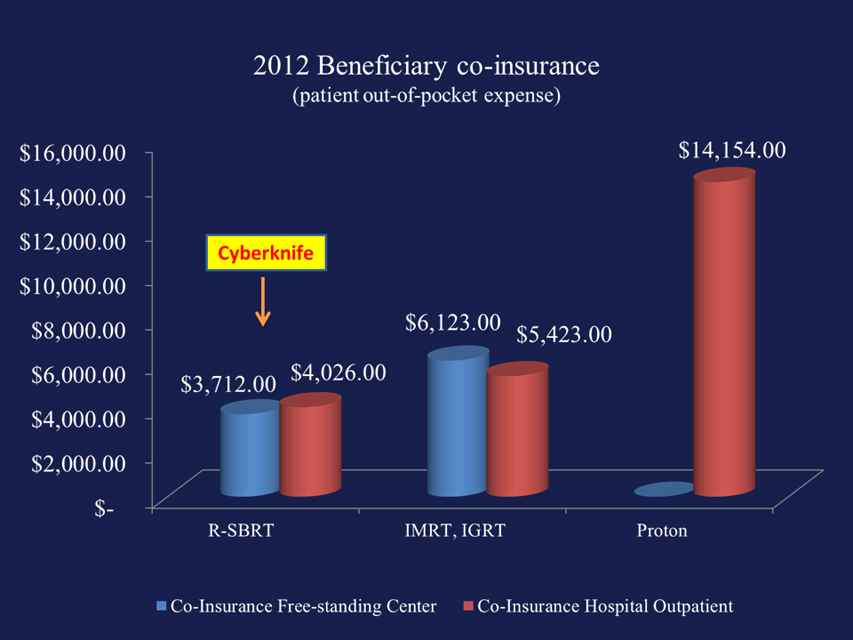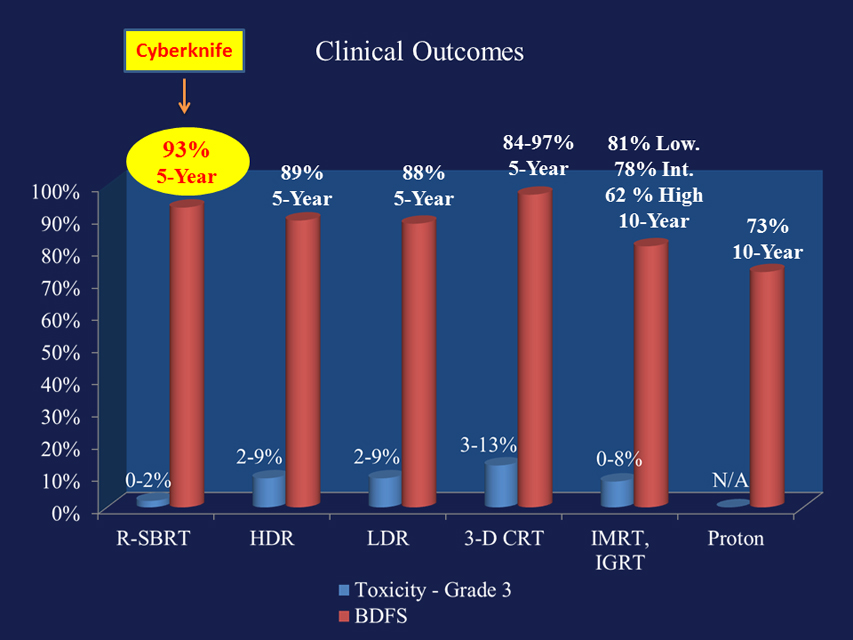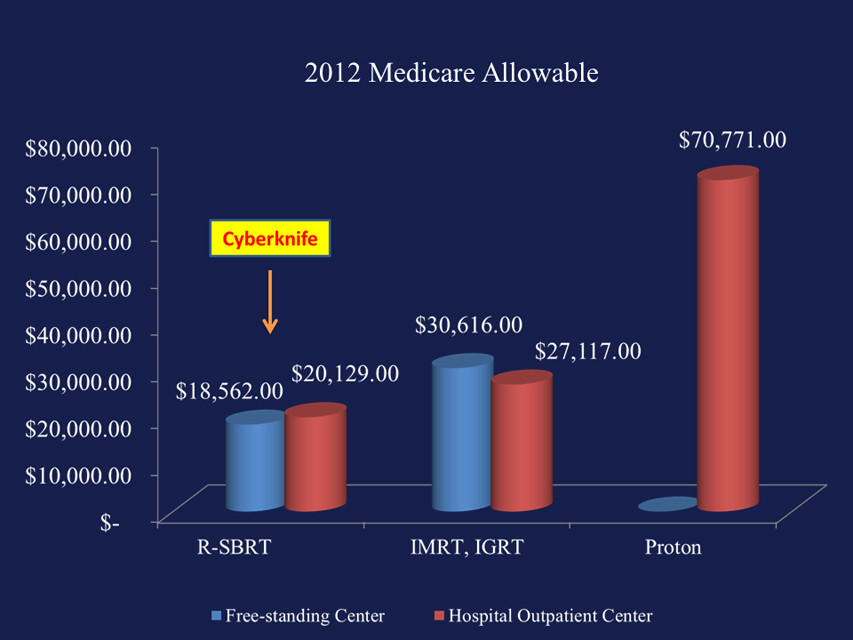Radiation Treatment for Prostate Cancer
*Prostate Treatments are covered by Medicare and most insurance.
The Cyberknife prostate robotic treatment is not surgery; in fact, there is no cutting involved. Cyberknife is pinpoint accurate radiation that removes prostate tumors with surgical accuracy. Treatments are completed in 5 days or less vs. 43 days on conventional radiation therapy systems.
Learn More About Prostate Cancer, CyberKnife and Contact Us for a Consultation
Prostate cancer is one of the most common forms of cancer in men over 65, affecting approximately 14% of American men. At Pasadena CyberKnife Center, our cancer doctors are experts in treating prostate cancer, as well as a wide variety of other types of cancer. Our state-of-the-art CyberKnife treatment is a non-invasive, non-surgical treatment solution that can treat prostate cancer effectively, comfortably, and safely – all without prostate cancer surgery, scars, or uncomfortable immobility devices. No matter what you are facing, our cancer center team at Pasadena CyberKnife Center will help you through every stage of your treatment.
There is a lot to learn about the type of cancer you have and the treatment options. We want to make sure that you are completely informed about your cancer and the CyberKnife treatment. After reading the information below, contact us to set up a consultation with our cancer doctor to see if CyberKnife is the right treatment for you.
About the Prostate
The prostate is a small gland, about the size of a walnut, that sits just underneath the bladder and surrounds the urethra, which is the tube that carries urine from the bladder and out of the body. The prostate secretes the base fluid for semen, and it sits just in front of the rectum, which is why doctors can check for prostate cancer with a rectal exam.
Prostate cancer occurs when cells in the prostate grow abnormally, eventually forming a lump in the prostate and sometimes spreading to other parts of the body. Around 90% of prostate cancer cases are of a type called acinar adenocarcinoma, which begins in the gland cells of the prostate, grows slowly, and is unlikely to spread to other parts of the body. The remaining 10% of cases are classified as one of six other types of prostate cancer. Unfortunately, because these cancers are so rare, less is known about how best to treat them.

See Also: Prostate Cancer Symptoms Prostate Cancer
See Also: Types of Prostate Cancer
Your Board-Certified Radiation Oncologists at Pasadena Cyberknife Center provide the most advanced prostate cancer treatment in Los Angeles offering three of the most advanced alternatives to surgery via radiation technologies.
What is CyberKnife Robotic Prostate Treatment?
What is CyberKnife Prostate Robotic Prostate Treatment?
Despite its name, the Pasadena CyberKnife System is not a prostate cancer surgery. In fact, there is no cutting involved at all. Instead, the robotic CyberKnife System delivers high doses of precise radiation (called Stereotactic Body Radiation Therapy (SBRT)), directly to the prostate cancer once per day for five days or less vs. 43 days on IMRT, and 35 days on Proton Therapy. Each of these treatment sessions is called a “fraction.”
The robotic CyberKnife System is a linear accelerator mounted to a robotic arm that is specifically designed to deliver stereotactic radiation from hundreds of different angles. Given this robotic maneuverability, healthy tissue is spared, and higher doses targeting the prostate are delivered exactly where it counts most.
The challenge faced in treating prostate tumors with radiation therapy is that the prostate gland moves unpredictably throughout the course of treatment, making the ability to track, detect, and correct for motion critically important. The Pasadena CyberKnife robotic System continually tracks and automatically corrects for the movement of the prostate in real-time. This enables the system to correct the beam direction so that it is focused on the prostate throughout the entire treatment, maintaining sub-millimeter accuracy, sparing healthy tissue. The robot constantly monitors and aligns the real-time location of the prostate to ensure any adjustments in the beam delivery match the prepared treatment plan while automatically correcting for any movement during a treatment by relaying critical logistical information to the system software. Safety mechanisms are in place to ensure that the beam of radiation is ‘locked on’ to the intended target should the prostate move out of acceptable range.
CyberKnife Robotic Prostate Treatment delivers radiation therapy for prostate cancer directly to the tumors themselves. Unlike conventional radiation for prostate cancer, which delivers radiation to both healthy and cancerous tissues, CyberKnife Robotic Prostate Treatment protects healthy tissue from radiation damage. It simply focuses the radiation on the cancerous tissue.
CyberKnife delivers a high dose of targeted radiation over a period of 30 to 90 minutes. The procedure is more comfortable than conventional radiation for prostate cancer. Treatment is usually complete in one to five sessions, delivered over a period of one to five days. Side effects are typically minimal, and success rates are high.
Cyberknife History
The CyberKnife® Robotic Radiosurgery System was cleared by the U.S. Food and Drug Administration in 2001 to treat tumors anywhere in the body, including the prostate.
Long Term Outcomes available: (see clinical and cost comparisons tab)
What is SBRT/SRS Radiation Therapy?
What is SBRT/SRS Radiation Therapy?
Stereotactic Body Radiation Therapy (SBRT), also called Stereotactic RadioSurgery (SRS), is the most advanced form of Radiation Therapy. SBRT and SRS are techniques used in Radiation Therapy to ablate (destroy) diseased tissue by precisely directing very high doses of radiation, while avoiding surrounding normal tissue. Unlike conventional radiation therapy (IMRT, IGRT and Proton Therapy), (43 consecutive treatments and 35 consecutive treatments respectively), SBRT and SRS treatments are given once per day for five days or less.
The robotic CyberKnife VSI System is the only technology specifically designed to perform SRS and SBRT treatments with sub-millimeter accuracy. During treatment, and prior to each beam, the robotic CyberKnife VSI System takes digital images to ensure that the radiation beam is aimed at the target. And when there is movement, (which occurs with all conditions within the body), the robotic CyberKnife VSI system precisely adjusts the position of the radiation beam under robotic control to keep it on target, sparing healthy tissue.
A problem with conventional radiation treatment for prostate cancer has been that the prostate — and any tumors within it — tends to move involuntarily in response to body functions. CyberKnife Stereotactic Body Radiation Therapy (SBRT), also known as Stereotactic Radiosurgery (SRS), solves this problem by tracking tumor movements. Cancer doctors use fiducial markers to help the CyberKnife System keep track of the tumor’s position, even as it moves. Fiducial markers are tiny, gold-colored seeds inserted into the prostate with a needle.
The insertion is an outpatient procedure, though you may need an enema to clean your rectum prior to fiducial insertion. Three to five fiducials are inserted a week before your prostate cancer radiation treatment.
SRS is typically used to describe treatments specific to the head and neck, while SBRT commonly refers to treatments anywhere else in the body.
What is the Cyberknife VSI Treatment Process?
What is the Cyberknife VSI Treatment Process?
Pasadena Cyberknife® robotic treatments involve a team approach in which several specialists from our oncology center participate.Prior to the procedure, the patient is imaged using a high-resolution CT scanner, to determine the size, shape, and location of the tumor. Following the CT scan, the image data is digitally transferred to the Pasadena CyberKnife VSI System’s workstation, where the treatment planning begins.
Your Board Certified physician then uses the CyberKnife VSI software to generate your specific treatment plan. The plan is used to match the desired radiation dose to the identified tumor location while limiting radiation exposure to the surrounding healthy tissue. Once the treatment plan has been developed, you are ready to undergo treatment.
The process of prostate cancer radiation treatment with CyberKnife begins by placing the fiducial markers. These tiny golden seeds help the CyberKnife system locate your tumor and track its movements.
Next, your treatment team creates your treatment cradle. The cradle is made from soft material that conforms to your shape. You’ll lie in the treatment cradle during each session. It will help you maintain your physical position from one treatment to the next and ensure your comfort during treatments.
During treatment, you’ll lie still and relax as the robotic arm of the CyberKnife moves around your body. It will send a targeted beam of radiation to your prostate from every angle. After each session, you can go home and resume your normal routine.
After arriving at our cancer center, patients are comfortably positioned on the treatment table. Then the Pasadena CyberKnife VSI System’s computer-controlled robot will slowly move around you to the various locations from which it will deliver radiation to the tumor.
Watch How CyberKnife WorksEach treatment session will last between 20 and 45 minutes, once per day for five days or less. Patients may experience some minimal side effects, but those often go away within the first week or two after treatment.
Risk Factors for Prostate Cancer
Only a few risk factors have been conclusively proven to have a causal effect on one’s chance of getting prostate cancer, but there are many more factors that may have an impact. Some factors are widely rumored to be risk factors for prostate cancer but, in fact, have no link to prostate cancer. Keep in mind, however, that having any of these risk factors doesn’t mean you are guaranteed to get prostate cancer.
- Age: Prostate cancer chiefly affects older men. It’s extremely unlikely for men under 40, but the chances of having it rise to 1 in 38 for men aged 40 to 59 and up to 1 in 14 for men aged 60 to 69. Over 65% of cases are diagnosed in men over 65, and the average age at diagnosis is 69 years old. After age 69, prostate cancer becomes more common than any other cancer.
- Race/Ethnicity: While the reasons for this are not understood, African American men are more likely to contract and 2.5 times as likely to die from prostate cancer as compared to Caucasian men. Asian-American and Hispanic men, however, are less likely to develop prostate cancer than whites. Asian men living in Asia have the lowest risk of all.
- Geography: If you live north of 40º latitude, you have a higher risk of dying from prostate cancer than any other men in the U.S. This isn’t fully understood, but researchers believe this may be caused by chronic Vitamin D deficiency due to limited exposure to sunlight. On a global scale, prostate cancer is far more common in North America, Europe, Australia, and the Caribbean than in Asia, Africa, or Central and South America. Researchers don’t understand the reason for this discrepancy, but lifestyle may play an important role. Asian men living in rural China have only a 2% chance of developing prostate cancer, but their risk increases significantly after moving to a western culture.
Family History: Men who have an immediate family member with prostate cancer are twice as likely to develop prostate cancer, and the risk is even more significant if a family member was diagnosed early than 55 years of age.
- Genetics: Some genes appear to raise risk of prostate cancer, but this accounts for only a small number of cases.
- Potential Factors: While the link between these factors and prostate cancer hasn’t been conclusively established, there are a number of factors that seem to potentially increase risk, including: diet, sexually transmitted diseases, smoking, prostate inflammation, chemical exposure, obesity, and having had a vasectomy.
- Mythical Factors: Some factors that are commonly believed to increase risk for prostate cancer have no effect at all in reality. This includes the level of sexual activity, certain medications like aspirin, alcohol consumption, and Vitamin E.
Stages and Types of Prostate Cancer
Prostate Cancer – Early Stage
Stereotactic Body Radiotherapy (SBRT), sometimes called stereotactic radiosurgery (SRS) or stereotactic ablative body radiation (SABR) is the most advanced form of treatment of early-stage prostate cancer. The robotic Cyberknife VSI is the only radiation technology which uses real-time tumor tracking to make adjustments for prostate, bladder, and rectal motion during the actual delivery of radiation. This allows hundreds of radiation beams to be focused on the prostate with sub-millimeter accuracy while avoiding the adjacent bladder and rectum, sparing these organs from the risk of high doses of radiation.
The robotic Cyberknife VSI radiation treatments are given over four or five treatment days compared to approximately forty treatment days for standard IMRT (Intensity Modulated Radiation Therapy) and Proton Therapy treatments.
Prostate Cancer – Locally Recurrent
The ideal treatment in this instance is determined in large part by which treatments the patient has already received. If a patient has previously undergone radiation in the form of IMRT or brachytherapy, and the PSA rises after treatments, the standard treatment would be to undergo androgen deprivation therapy (ADT).
If the PSA rises after prostatectomy, the first step is to see if there is any detectable evidence of recurrent prostate cancer by undergoing various radiological examinations such as bone scan, CT scans, and possibly, an MRI of the pelvis. Often there will be nothing apparent on these scans, despite a rising PSA. One treatment option is to deliver radiation to the area where the prostate used to, the prostatic fossa. This radiation is standardly done over several weeks using IMRT. The same type of radiation is often given immediately after prostatectomy if there are adverse pathological features such as a positive surgical margin or growth of the tumor through the prostate.
Occasionally, there is recurrent prostate cancer that is apparent on imaging studies such as an MRI of the pelvis. In this situation, Cyberknife radiosurgery can be used to treat a recurrent tumor in the pelvis. This treatment can be considered among the range of options to be discussed with your physician.
Prostate Cancer – Local, Advanced, and Unfavorable
Patients with prostate cancer who have a PSA > 20 ng/ml, Gleason score >7, or a significant involvement of the prostate on physical examination, benefit from more aggressive treatment than a single radiation modality or hormonal therapy alone. A combination of treatments can be used along with androgen deprivation therapy (ADT) to afford the best chance of eliminating cancer in the prostate gland and tumor cells that have spread outside the prostate. Cyberknife alone is not appropriate as a single treatment modality for locally advanced prostate cancer outside of a clinical trial.
An escalated dose of radiation in the form of external beam radiation (IMRT) plus internal radiation (brachytherapy) or Cyberknife can be delivered along with ADT for the optimal combined approach for treatment of locally advanced prostate cancer. Although brachytherapy has standardly been used for additional ‘boost’ radiation to the prostate, Cyberknife Stereotactic Body Radiation Therapy offers an attractive alternative to brachytherapy as there is no need for anesthesia or the placement of multiple treatment catheters into the prostate.
Contact Your Pasadena Oncology Center Today!
Any cancer diagnosis is scary, but at Pasadena CyberKnife Center, we are here to support you through your entire treatment process. We’re proud to provide world-class cancer treatments to patients throughout the Pasadena and greater LA area. With our state-of-the-art radiation therapy cancer treatments, we are able to treat patients with a wide variety of conditions.
If you or a loved one have recently been diagnosed with cancer, there is hope. To learn more about CyberKnife, call us today at (626) 768-1021 to schedule a consultation. Our contact page also provides information on our location and hours. Let the cancer experts at Pasadena CyberKnife Center help you beat cancer to reclaim a healthy, happy life.

Watch Videos About CyberKnife and Treating Prostate Cancer
CyberKnife® Benefits Explained By Surgeons
Prostate Cancer Treatment: CyberKnife® Patient Education
Prostate Cancer Patient Testimonial: Peter’s CyberKnife Journey
Prostate Cancer Commercial
Prostate Cancer Charts & Graphs – Insurance, Clinical Outcomes, and Medicare
2012-Patient Out Of Pocket Expense
2012 – Patient Out Of Pocket Expense

Clinical Outcomes
Clinical Outcomes

2012 Medicare Allowable
2012 Medicare Allowable

For more information on CyberKnife’s ability to treat Brain Tumors, check out our Case Studies.
Contact Your Pasadena Cancer Treatment Center
Any cancer diagnosis is scary, but at Pasadena CyberKnife Center, we are here to support you through the entirety of your treatment. We’re proud to provide world-class cancer treatments to patients throughout the Pasadena and greater LA area, and our state-of-the-art radiation therapy cancer treatments allow us to treat patients with a wide variety of conditions. If you or a loved one have recently been diagnosed with cancer, there is hope. Call us today at (626) 768-1021 or reach out to us at our contact page to find out how we can help you beat your cancer and reclaim a healthy, happy life.
